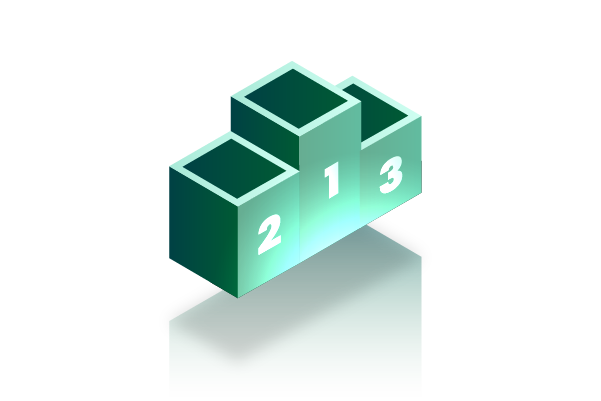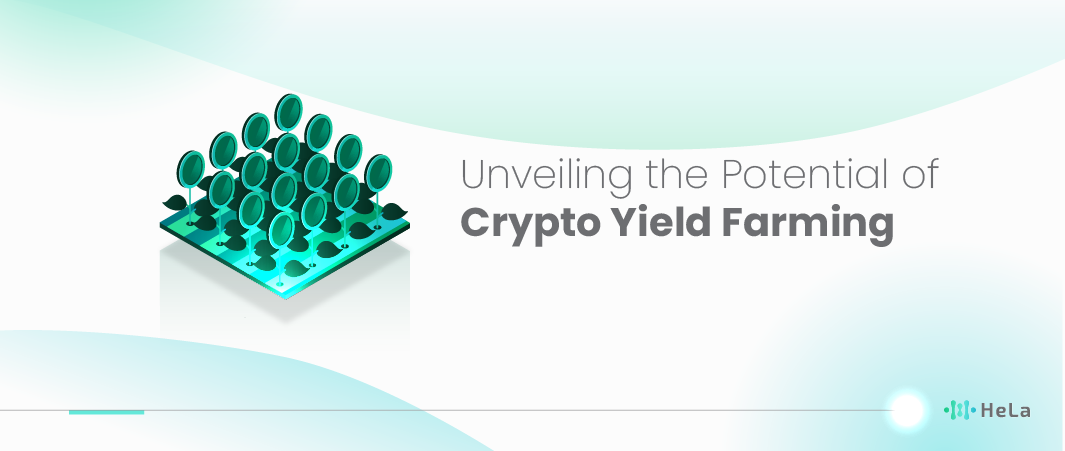Yield Farming is a concept in decentralized finance whereby users stake their tokens in various DeFi projects in order to earn gains or yield. This process is based on decentralized principles of the blockchain and smart contracts in order to achieve maximum revenues. Yield farming commonly involves offering liquidity in decentralized exchanges or providing deposits to lending protocols. Liquidity pools are contracts where users store their crypto assets to be used for lending. In return, they receive bonuses, which are often in the form of more tokens of the same cryptocurrency. These earned tokens can be reinvested in order to gain even more tokens, a process known as ‘yield farming’.
Such popular decentralized applications are Uniswap – a DEX where users profit from trading fees, Compound is a platform for earning interest and borrowing from collateral, Aave is a lending platform, and SushiSwap that has additional mechanisms, for example, staking of its token. However, yield farming has its drawbacks, including the possible loss due to impermanent loss, malicious smart contract actions, fluctuating markets, and regulatory challenges. On the other hand, it has high returns as compared to the traditional financial instruments, one can directly invest without involving any middle man and there is evolution within the DeFi market.
What is Crypto Yield Farming?

Yield farming in the cryptocurrency is an intricate derivative of decentralized financing where investors provide their cryptocurrency tokens to DeFi protocols for lending and staking to generate returns in form of extra cryptocurrencies. This function can be compared to conventional farming as seeds are sown (crypto assets staked) to grow crops (rewards or yields). Yield farming mainly entails supplying liquidity to decentralized trading platforms (AMMs) or lending platforms. These platforms utilize the funded capital to enable trading, lending, and borrowing within the DeFi space.
When investors provide liquidity, they are effectively entering into a liquidity pool and putting their assets into a common pool with other investors. The liquidity pools are essential for the functioning of DEXs as they allow for the direct exchange of tokens without involving an intermediary. As a result, the liquidity providers receive some fractions of the transaction fees which occur within the platform. Also, the staking incentives may be in the form of governance tokens, which sometimes give their holders the rights to make decisions regarding the platform’s operations and may increase in value.
Yield farming may also use smart contracts as agreements that automatically execute and include its terms within codes. These smart contracts assist in the determination of the rewards which enhance efficiency and reduced influence of biases. Yield farming can be risky and rewarding in different ways based on the strategies adopted by the investors, which include staking stable coins of relatively lower yields or getting involved with risky tokens of relatively higher yields.
Also Read: 10 Best Cryptocurrency YouTube Channels to Watch in 2025
However, yield farming is dangerous in the following ways: The actual amount of money that is invested in the staked assets may also significantly vary due to market influences affecting specific returns. There is also another form of loss known as impermanent loss and it comes up when one decides to exchange their coins or tokens for other assets and then intends to sell them back at a loss compared to when they initially invested. Moreover, Smart Contracts which seem to be very efficient can also have some bugs or be exploited which goes against the security. There is also the risk of platform-specific events that affect the ability to trade, for instance, a liquidity event or a protocol failure which is rather catastrophic for investors.
Mechanisms of Yield Farming

Like other investing and trading activities in DeFi, yield farming also utilizes smart contracts that enable borrowing, lending, as well as exchange of capital. These are locked into a smart contract address relevant to a specific protocol and can have different lockup times. The mechanics of yield farming depend on the specific protocol and the plan in use below:
Underlying protocols and mechanisms
These protocols and mechanisms in yield farming that take place in the background of cryptocurrency form the basis of a great and highly profitable environment in the DeFi market. The concept of yield farming can be understood as users offering their funds to become liquidity providers in decentralized exchanges (DEXs) or other platforms in return for additional tokens or an interest rate. This process usually involves the use of smart contracts that help in the exchanges of properties and the distribution of the incentives according to the set norms.
At the base of these smart contracts lay various protocols such as the Automated Market Maker (AMM) like Uniswap, Balancer where the trading of the asset takes place without relying on an order book. Further, yield farming may involve liquidity pools, meaning that users provide their tokens to be utilized for trading purposes and gain a cut from the trading fees. Also, through token staking or liquidity mining, protocols may offer rewards for participation and to help maintain the proper functioning and sustainability of the platform. However, one should always remember that yield farming is not protected against risks such as impermanent loss, utilizing smart contracts, and the participants must first analyze the risks, identifying them and using their judgement before participating.
Key Components of Crypto Yield Farming
Yield farming is a process that is often used by investors in the decentralized finance domain to earn passive income and also to get higher returns on their investments. Yield farming is essentially the process of using different DeFi platforms for the purpose of generating returns in the form of interest, fees, and tokens. Here’s an introduction to the key components:
Staking
In yield farming, staking is the process of putting your cryptocurrency coins or tokens in a digital wallet to invest in a blockchain activity. In this process, participants, known as validators or stakers, stake their tokens to become parties responsible for securing the network and processing transactions. For this purpose, participants invest their money and the rewards are usually offered in the form of more coins. Such benefits make the users to be more inclined in contributing to the network maintenance and security.
Staking is a core feature incorporated in the majority of DeFi platforms where people receive passive income in exchange for participating in blockchain networks. However, the participants should be aware of some of the factors that may affect their staking such as, the change in token value and the security of the protocol. In conclusion, staking is a vital component in ensuring the development and success of decentralized ecosystems since it ensures the security of the network and encourages the engagement of stakeholders.
Lending
Yield farming, in the context of lending, means that the borrower deposits their crypto to liquidity pools or various DeFi protocols to earn interest or other incentives. This process often takes place within decentralized finance applications in blockchain-based platforms such as Ethereum. Yield farmers can borrow their own tokens like Ethereum or provide stablecoins like DAI to these lending protocols where it can be applied for various uses, including providing liquidity for decentralized exchanges or putting up as collateral for a loan.
For providing their assets, users get the interest in the form of benefits or staking rewards that are offered in the form of platform tokens or governance tokens. Yield farming, which is a kind of lending in decentralized finance spaces, can bring higher returns than standard banking systems because they are decentralized and no middleman is involved in the process. However, participants should consider and weigh the risks in relation to smart contract flaws, market instability, and other liquidity risks inherent in decentralized structures.
Providing Liquidity
Liquidity in the yield farm scenario pertains to the contribution of funds where users deposit their tokens in a liquidity pool or in decentralized finance (DeFi) arenas to perform trading activities and earn profits. Market makers add pairs of tokens to these pools, so that traders can move fluidly between one token and the other. Providers, in turn, earn their cuts in the fees resulting from the volume of the available liquidity, as well as, often, additional tokens issued by the platform.
Yield farming plays into these rewards by offering even greater incentives for users to provide liquidity in return for even more tokens or other yield-generating assets. But it is helpful to understand the drawbacks that are probably known to everyone, but it is better to recall them before investing: Impermanent Loss, which means that the ratio of the tokens added to the pool is not fixed and can shift over a period of time. The risks involved in making large volumes at such high returns must be taken with caution or in cooperation with well-thought-out market trends that may affect the crypto yield farming.
10 Best Crypto Yield Farmings to know in 2025

Yield farming is a common practice among DeFi projects, where users can earn profits for providing their cryptocurrencies to several projects. This process entails storing cryptocurrencies and providing traders or borrowers with trading or borrowing capacities in decentralized exchanges or lending platforms.
The concept of risk in yield farming is in the opportunities the DeFi platforms have for fluctuation so that the high yields attract investors. Yield farmers have to analyze various conditions such as the popularity and reliability of the platforms, available tokens, withdrawal conditions of every platform, as well as possible dangers connected with this sort of activity. Here are ten of the best platforms for crypto yield farming in 2025:
1. StableHodl
StableHodl represents a groundbreaking platform within the realm of Stablecoin Yield Generation, distinguished by its reliance on the innovative HeLa Network. As a pioneering force in the industry, StableHodl has revolutionized the way investors engage with stablecoins, providing a secure and efficient means of generating yield. The platform leverages cutting-edge technology and sophisticated financial strategies to offer users unparalleled opportunities for stable and consistent returns.
The HeLa Network, at the core of StableHodl’s operations, is a state-of-the-art blockchain network renowned for its reliability, speed, and security. This advanced network architecture ensures that all transactions are processed with utmost efficiency and safety, fostering a trustworthy environment for investors. By integrating the HeLa Network, StableHodl is able to provide a seamless user experience, characterized by fast transaction times, low fees, and robust security measures.
2. Aave (AAVE)
Aave is a DeFi platform that provides users with interfaces to lend and borrow cryptocurrency with no middlemen such as banks. It was created in 2017 by its founder Stani Kulechov, and it started with the name of ETHLend, and later, in 2018, it was renamed as Aave. Aave is integrated on the Ethereum blockchain platform, and the lending process is handled by executing smart contracts. Lenders get paid based on the interest accrued by the funds deposited in liquidity pools while borrowers are able to borrow funds using cryptocurrency as collateral.
Aave has a special flash loans system where you can borrow assets and don’t have to put up collateral for them, but you have to repay those in the same transaction block as you borrowed them. It also has rate switching which enables a borrower to change from a stable or fixed rate in order to control their cost of borrowing. The native token of this protocol is AAVE, which has a role of governing the protocol since token holders get to decide on some crucial decisions and changes. Being one of the leading DeFi protocols, Aave has made a great contribution to the evolution of DeFi sphere.
3. PancakeSwap (CAKE)
PancakeSwap is a decentralized exchange platform developed on the Binance Smart Chain platform and is admired for its low fees and high speed of transactions. It was created in September 2020 and uses an AMM model through which users can trade tokens directly from the liquidity pools, unlike a conventional order book. It has staking, yield farming, and lottery functions, allowing it to be an all in one DeFi platform.
For example, users need to engage in various activities like supplying liquidity to earn the platform’s token known as CAKE. PancakeSwap has quickly become popular thanks to the simple navigation, unique features, and an active community that creates the platform, making it one of the most successful DEXs in the DeFi sector.
4. SushiSwap (SUSHI)
SushiSwap is an Ethereum based DEX designed to facilitate peer to peer trading of tokens in a decentralized and anonymous way. A product that was initiated in August 2020 as an Uniswap clone, SushiSwap has some extended capabilities including yield farming and staking.
Users can deposit and supply various tokens to different trading pairs and earn SUSHI tokens in return, as well as earn fees for adding liquidity to the pools, SUSHI tokens are used as both rewards and governance tokens. Paving way for a decentralized and fairer trading ecosystem is the primary goal of SushiSwap that distributes trading fees to those who provide liquidity and stake SUSHI. It also has the lending, margin trading, and launchpad services, making it a complete DeFi application.
5. Synthetix Network (SNX)
Synthetix Network is a DeFi venture developed on the Ethereum platform that focuses on synthetic assets creation and trading. These synthetic assets directly mimic the behavior of real-world assets such as fiat currencies, commodities, stocks and even other cryptocurrencies, meaning that instead of directly owning any of these assets one can indirectly invest in them. This operates through smart contracts where users stake their SNX tokens as collateral to earn synthetic assets.
This is what makes Synthetix use the decentralized collateralization model, this system guarantees the safety of the platform because it encourages users to work for the peg of synthetic assets in the real world. This model also enables generation of new synthetic assets which are a requirement of the market hence giving the users many choices in the kind of assets to invest in. Thus, Synthetix Network constitutes a very important part of a new generation of decentralized finance platforms inheriting such advantages as decentralization, continuous growth, and expansion of the ecosystem offering users an opportunity to receive permissionless and borderless financial services.
6. Curve DAO (CRV)
Curve DAO is a decentralized autonomous organization that is being developed on Ethereum and its major purpose is to supply liquidity to stablecoins and other low volatility assets. Curve Finance is new and launched in the year 2020, and what it provides is a range of automated market maker or AMM pools that are designed to trade stablecoins with low slippage and lowest possible transaction fees.
The Curve DAO manages the staking of existing tokens and enables those who hold tokens to make and vote on changes to the Curve’s parameters, control the treasury, and implement platform modifications. The DAO has its native digital asset, CRV, whose holders have voting rights that are in line with the amount of holdings they possess in the governance of the platform. Given that Curve DAO is focused on stability, efficiency, and the direct governance of the community, it has become one of the significant partners of the DeFi industry, helping boost decentralized trading capabilities.
7. Yearn.Finance (YFI)
Yearn.Finance is a decentralized finance (DeFi) protocol based on the Ethereum platform. Yearn was founded in July 2020 by Andre Cronje. Finance sets out to maximize yield farming by constantly swapping between different DeFi platforms in ways that are most beneficial to users. At its core, Yearn. Finance acts as a yield optimization tool, allowing its users to receive the highest possible rewards for their crypto investments with little to no input.
Among them, The yVaults is one of the product offerings that helps to simplify yield farming by investing the user’s funds into different pools and strategies. Yearn.Finance became one of the most demanded products in the DeFi market due to its ambitious vision and a unique model for generating revenue based on yield farming and its governance token YFI. The project has not only introduced new products and partnerships over time to complement what they offer within the DeFi industry.
8. Venus (XVS)
Venus (XVS) is an autonomous financial system based on DeFi with a focus on launching a blockchain-based financial platform on the Binance Smart Chain (BSC). Anashboard is an ATBO-based lending and borrowing system for the Binance ecosystem launched in 2020. Using algorithms and smart contracts, Venus enables users to provide this, that or the other cryptocurrency as security and to take a different cryptocurrency as a loan.
Also Read: 7 Top Crypto News Websites to Visit in 2024
This serves a purpose of helping the users to receive interest from their deposited valuables besides offering them an opportunity to access cash through borrowing. The platform also has an integrated governance token called VSN, which lets users vote on protocol updates and enhancements. As a result of combining USDP’s focus on-efficiency and its accessibility, it has gained much popularity in the sphere of the DeFi movement and provides its users with passive income earning options as well as financial facilities.
9. JOE(JOE)
JOE (JOE) is a digital currency that operates differently from other virtual currencies present within the current market. They are built as a decentralized platform and the project that relies on the community’s engagement, with the main goal to provide the population with financial services and an opportunity to participate in the decision-making process. One of its primary characteristics is its focus on the responsible use of resources derived from the environment, namely, the implementation of a proof-of-stake consensus algorithm that is less energy-intensive than the proof-of-work method.
JOE has built a strong community of users who are involved in making decisions through well-structured governance frameworks. As such, JOE aims to present a new model of DeFi where users can ensure accessible, secure, and sustainable economic interactions and become a part of a bigger picture of the future financial world.
10. Raydium (RAY)
Raydium (RAY) is an advanced DeFi platform that offers decentralized exchange (DEX) and automated market maker (AMM) services on the Solana blockchain, distinguished by fast speeds and minimal fees. First started in January 2021, Raydium has become popular for its fast and convenient process and, of course, bindings with the Serum decentralized exchange layer.
As suggested by the design of Raydium, users can trade different tokens, stake and provide their tokens in liquidity pools, as well as gain from yield farming. Furthermore, the project uses the Raydium concept of the “Ray pools”, which are the liquidity pools for users who can earn even more rewards. As an efficient AMM optimized for scalability, Raydium will grow alongside Solana, serving important functions in the rapidly developing DeFi space.
Conclusion
Analyzing the crypto yield farming in the year 2024 it can be said that there is a lot of change in terms of development in projects and income is also very good for all those who are involved in it. In this list of the leading competitors, it is possible to find a set of values that are unique to each platform, providing users with an attractive offer while maximizing profits. DeFi protocols, launchpads, NFT marketplaces, and governance tokens are all part of the available offerings which generally allows people to find what they want depending on their risk tolerance and investment approach. While markets continue to emerge and evolve in this nascent industry, due diligence and risk assessment never take a backseat.
Despite the seemingly high-profit potential, yield farming should be entered with the eyes open, by taking into account the characteristics such as smart contract investment safety, liquidity fluctuations, and volatility. Due to a high rate of change and innovation in the overall cryptocurrency market, being informed and prepared will be the key to the most effective utilization of opportunities and minimization of possible risks in the context of sustainable crypto yield farming.
Disclaimer: The information provided by HeLa Labs in this article is intended for general informational purposes and does not reflect the company’s opinion. It is not intended as investment advice or a recommendation. Readers are strongly advised to conduct their own thorough research and consult with a qualified financial advisor before making any financial decisions.

